|
|
GENERAL EQUIPMENT INC.
8724 Sunset Drive #191● Miami FL 33173 · USA
|
|
|
GENERAL EQUIPMENT INC.
8724 Sunset Drive #191● Miami FL 33173 · USA
|
ACSTERIL
|
TYPE: |
Sterilization |
|
DESCRIPTION: |
Aircraft Sterilization System |
|
PRICE: |
Upon Request |
|
PACKING: |
Upon Request |
Aircraft STERILIZATION SYSTEM



Quarantine the passengers but what about the jet they came in on?...
it still has the virus onboard to spread to the next boarding passengers...!
WASHINGTON --- Scientists at Indiana University have come up with a new mathematical model to try to predict how pandemic diseases will be spread around the globe by sick people traveling on airliners. "These people will be the seed for the disease in the city in which they arrive," said Alessandro Vespignani, a professor of informatics who co-authored the study. 'Knowing the traffic fluxes of people among cities will allow us to determine how many people will travle from one place to another, and then to estimate how many of these people were carrying the disease." Ninety-five percent of intercontinental travel is on commercial planes.
Now this is when the Aicraft Sterilization System comes into play....it kills 100% of all known viruses on board any aircraft.....at the gate....to keep the disease from spreading to the next boarding passengers and crew!
The Need
Experts feel there is a growing threat of another global infectious
disease emergency, such as SARS or Asian Bird Flu, which could
travel around the globe in hours aboard commercial and/or military
aircraft. In the event of such an outbreak, it would be critically
important to keep all transportation assets operable. In order to
accomplish this, aircraft would have to be decontaminated in a
rapid, safe and cost-efficient manner.
This system
was developed as a
means to address these issues.
Applications
Though the process is focused primarily on the
eradication of viruses in aircraft, the process can be easily
adapted to treat other threats in or on other transportation assets
including:
•
Military Vehicles
•
Ambulances
•
Fire/Rescue Equipment
•
Busses
•
Trains
•
Boats & Ships
•
Emergency Management
Emergency Management/Homeland Security
Imagine this: you are in the middle of an escalating infectious disease emergency and the hospitals, already at capacity, are unable to accept more patients. Your staff rekindles the idea of a “Secondary Assessment and Treatment Center” or SATC. You’ve found the building and you have the manpower and equipment. Only problem is the building has been disconnected from the power grid so there is no way to heat or cool the building or power the necessary medical equipment….until now.
These units are designed to be regional emergency assets. An unit can provide power, heat and/or air conditioning to any building, turning it from an empty shell into a functioning SATC or field command center within minutes. Clean, conditioned air and power are essential to successful operations and this system can provide it…quickly. Our patented power-distribution unit (PDU) allows for any size hook up. The choices are limitless. From 480 volt three phase, 208 volt three phase to 120 volt single phase, our PDU leverages the workhorse Caterpillar diesel generator to supply up to 325 amps of 480 volt three phase power. So whether the need is to power a critical lift station, communications center or an entire building, this systme can do it.
The unit
can provide enough conditioned air to heat or cool a
big box structure of 100,000 square feet or more.
Imagine a fully functional SATC or field command
center in just minutes. Whether influenza, SARS,
Asian Bird Flu or smallpox;
this
might be just what you need to keep the
hospitals from collapsing from an infectious disease
emergency.
Violent weather and acts of nature can knock out
radio and cell towers, throwing a damper on even the
best emergency plans. With
this
system, one-button
operation allows even novice users to establish
satellite communications in minutes. From one to 50
satellite telephones can be hooked up by simply
plugging them into the Communication Distribution
Console (CDC). Within minutes you can reconnect to
the world…no matter where you are or what the
conditions may be.
Command staff, doctors,
victims and victims’ families are all able to
communicate again. Instant communication established
to and from anywhere in the world, with no special
equipment required on the receiving end.
Conditioned air, power and satellite communication right here and right now. It’s what you need when you need it…now, not several hours or days from now. Violent weather, biologic emergencies or massive power outages, they are what the public dreads and what you spend years planning for. Will you be ready or will you be searching for solutions?
no excuses.
LARGE SCALE DECONTAMINATION OF MOBILE ASSETS UTILIZING THE PORTABLE ASSET DECONTAMINATION SYSTEM (PADS)

EXECUTIVE SUMMARY
According to a recent report from the CDC, healthcare–associated infections (HAIs) costs US hospitals between $35.7 and $45 billion. They also estimate that the cost benefit of infection control interventions could yield annual savings of $25 to $31.5 billion1,2. Other studies have shown that greater than 50% of ambulances that transport hundreds of thousands of patients to hospitals are contaminated with methacillin-resistant staph aureus (MRSA) and other HAI pathogens3. In numerous studies, currently approved cleaning methods have been shown to be ineffective and, in many cases, actually spread the pathogens to other parts of the vehicle4.
Based on the theory that contaminated ambulances may serve as a vector for HAI spread to patients, crews and hospital staff, the factory design and build a large-scale, full-spectrum decontamination system that could provide a cost-effective solution for this rapidly escalating problem. This report highlights the results of those efforts.
The Portable Asset Decontamination System (PADS) provides a quick and cost-effective solution to decontamination of large assets, such as emergency vehicles and hospital rolling stock. The process has a low cost-percycle and provides a 6-log reduction of all pathogens from influenza to anthrax.
The process is verified using commercially available biologic indicators. The process is controlled with an easy to use computer interface, requires minimal training and is easily serviced. The PADS unit was designed to either be a freestanding facility or easily retrofitted into existing fire stations or other commercial buildings.
The results of the tests contained herein show consistent 6-log reduction in all parts of the test vehicle with no residual odor or damage to the vehicle or equipment. Though the cycle times for these tests average 2.5 hours, subsequent refinement of the process has lowered the cycle time to approximately 90 minutes. Consumables, including peroxide and electricity, are less than $100 per cycle.
We believe the PADS units will provide a direct economic benefit to the United States and all countries by:
1. Decreasing the spread of HAIs throughout the healthcare system and surrounding communities.
2. Decrease potential future claims by patients, crews and other healthcare workers because of suspected exposure to contaminated vehicles and equipment.
3. Allowing for the rapid recovery of ambulances and other critical transportation assets in the wake of a bioterrorist attack or global pandemic event.
INTRODUCTION
It is estimated that healthcare-associated infections (HAI) result in nearly $45 billion dollars in excess healthcare costs each year1,2. In addition to infections primarily associated with hospital admissions/surgeries, there are a growing number of increasingly virulent non-hospital acquired pathogens, such as community-acquired methacillin staph aureus (ca-MRSA). Near-epidemic increases in both the number of new cases and the severity of these emerging pathogens have made combating HAIs a top priority for the US Department of Health and Human Services.
The United States has a highly evolved and multi-tiered emergency medical services (EMS) system composed of over 50,000 ambulances and other rescue vehicles operated by cities, counties, hospitals and/or private providers. They transport hundreds of thousands of patients annually. Several studies in the US and the UK have demonstrated that approximately 50% of these vehicles are contaminated with MRSA and other HAIs3. Other studies have revealed that currently accepted cleaning methods are ineffective and may actually spread these organisms to other, previously non-contaminated, parts of the vehicles4. It is a reasonable assumption that contaminated emergency vehicles may result in the introduction and/or spread of HAIs throughout the healthcare system.
Contaminated vehicles may also result in increased illnesses among crew members with possible secondary transmission between crew and patient and/or crew and family members.
Ambulances and other rescue vehicles are a limited and expensive resource of the US healthcare system. In the event of a widespread bioterrorist or pandemic event, it would be imperative to keep these assets in service while insuring that they had been effectively decontaminated in an effort to prevent further spread of the pathogen. Currently proposed methods of decontaminating suspect vehicles require excessive manpower, can be ineffective if done improperly and could add further stress to an already overtaxed system.
Portable Asset Decontamination System
(PADS) that can quickly and cost effectively decontaminate large objects, such as emergency vehicles, to a greater than 6-log reduction using commercially available biologic indicators for process validation. In addition to ambulances and other emergency vehicles, PADS can be used for “batch decontamination” of hospital stretchers, wheelchairs, IV poles and other mobile assets that might result in a decrease of HAIs within the healthcare facility.
GENERAL INFORMATION
EQUIPMENT:
• Portable Asset Decontamination System
• STERIS® model M1000 ST4 VHP generator
• Draeger hydrogen peroxide sensors:
o Model 6809675 high-concentration sensor, calibration
o Model 6809705 low-concentration sensor, calibration
• Draeger Pac III hydrogen peroxide monitor, calibration
• Apex Labs 6-log biologic indicators (geobacillus stearothermophilus)
ATCC# 12980, lot H0089
• STERIS® Spordex® culture tubes, lot 9009007
• STERIS® VHP indicator strips, Lot 242216
• Bokel Scientific incubator, Model 13200, S/N 07814 calibration
• FMC 50% Durox® hydrogen peroxide, LR grade
• 1979 Ford modular Type III ambulance with a Miller Meteor body style
#879538

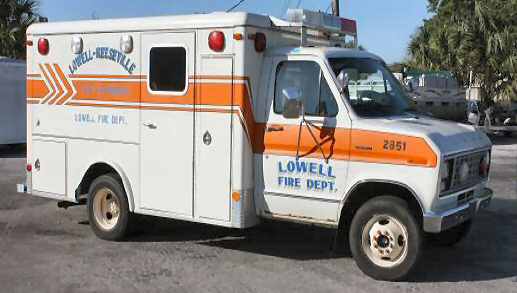
AeroClave outside unit Test ambulance
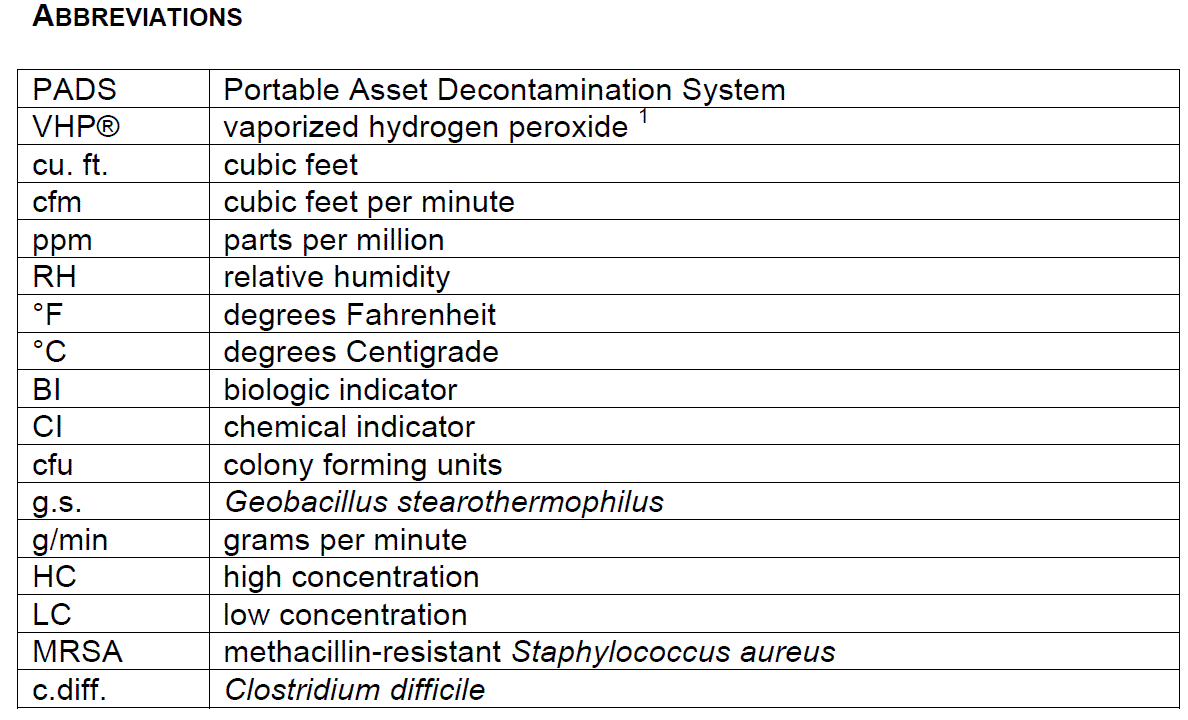
FACILITY
The test facility is located at 650 S. Capen Avenue, Winter Park, Florida
32792. It is a single-story concrete block building that is approximately
8000 square feet. The building has been divided so that approximately 4000
square feet is built out as conditioned office space and the remainder is
unconditioned warehouse space.
The treatment chamber in which these tests were conducted was erected inside the unconditioned space. This chamber has inside dimensions of 15.5 feet wide, 56.5 feet long and 14 feet high yielding a volume of approximately 12,260.5 cubic feet. The chamber is constructed of interlocking metal panels that have approximately three inches of high-density foam insulation sandwiched on either side by metal skins coated with a baked-on enamel paint finish.
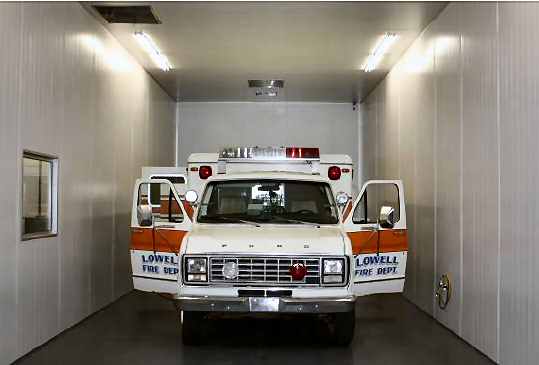

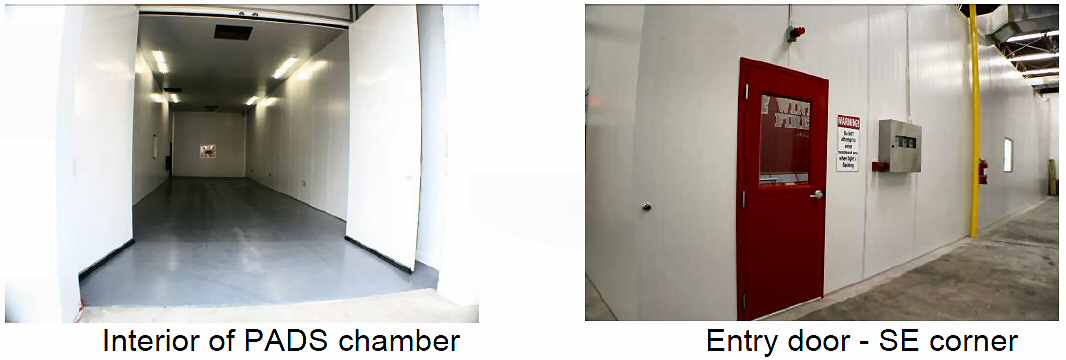
The floor of the treatment chamber was sealed and
painted using a commercial two-part epoxy finish. There are two 6’ x 12’
hinged doors on the north end ofthe chamber and one 3’ x 6’8” door on the
southeast corner. All doors are gasketed to prevent infiltration and/or
exfiltration.
The decontamination unit is located outside the building immediately
adjacent to the space housing the treatment chamber. It is connected to the
PADS treatment chamber by two 20” x 20” supplies and one 36” x 36” return
made of standard galvanized duct material that has been sealed with a
commercial mastic product to prevent air leakage and then wrapped with
insulation.
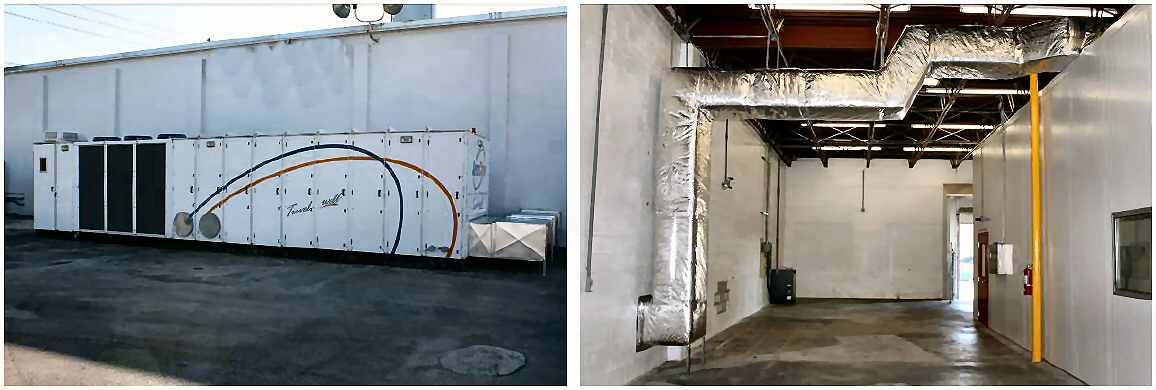
Outside unit Interior Insulated Duct
SAFETY MEASURES
Prior to any live VHP run, a risk assessment plan was developed and reviewed
by all personnel. Operational and safety materials from STERIS, FMC and
Draeger were reviewed and incorporated into the pre- and post-run safety
checklists and fumigation plans.
The building was smoke tested and any air leaks were sealed. As an added
safety measure, a 53,000 cfm rooftop ventilator was installed in the
warehouse portion of the treatment area and is kept running at all times
during PADS cycle operations. At two complete air changes per minute, any
potential VHP leak or accidental release from the sealed treatment chamber
would be immediately exhausted through this ventilator. The face velocity at
the 5’ high exit plenum of the fans is calculated at 48 mph, sufficient to
eject the exhaust air high into the atmosphere where dilution and natural
decomposition of VHP vapor to oxygen and water would occur.

The warehouse area adjacent to the treatment chamber
is constantly monitored by a Draeger low-concentration sensor capable of
detecting VHP levels down to 0.1 ppm. Roll-up doors at both ends of the
warehouse section of the building adjacent to the treatment chamber allow
for constant fresh air circulation during the treatment cycle.
After the vehicles are loaded into the treatment area, the operator closes
the double doors and bolts them from the inside. After the vehicle is
secured and prepped, the operator exits the chamber through the door located
at the southeast corner of the chamber. Warning strobe lights are activated
along with an electric door strike that prevents re-entry into the chamber
during the treatment process. In addition to the warning strobes, magnetic
caution tape is placed around the perimeter of the door jamb, providing
additional visual caution signals.
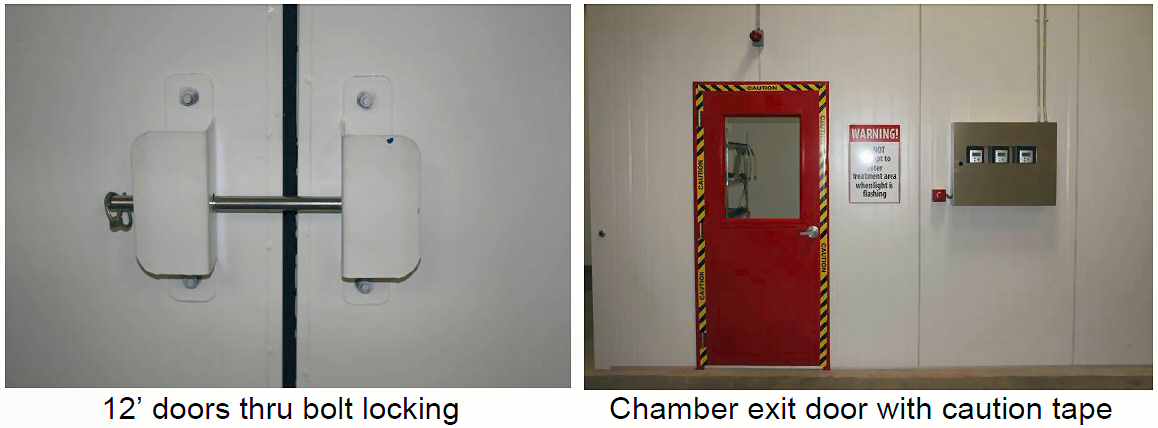
An emergency purge button is
located adjacent to the entry door and activation energizes a rooftop
ventilator that produces four complete air changes per minute.
Access to the warehouse area adjacent to the treatment chamber is limited by
gates that are closed during the operation. Closed-circuit surveillance
cameras allow for constant monitoring of the treatment area, the warehouse
area adjacent to the treatment area, the outdoor component of the unit and
the external perimeter of the building.
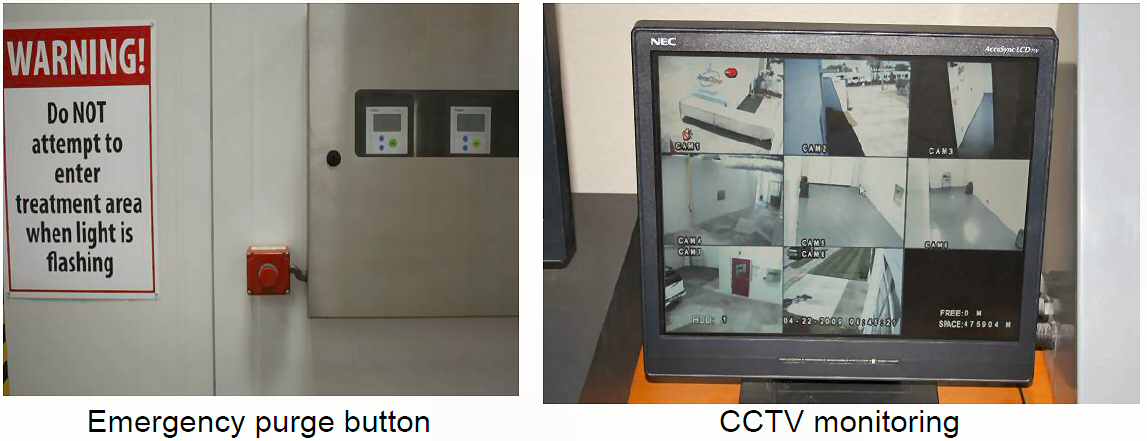
Internal safety protocols dictate that at least two trained operators be present during any PADS operation. Handheld low-concentration VHP sensors are carried by anyone venturing outside the control room during cycle operation.
Specification and photos are not contractual and are subject to verification upon inspection
TAKE NOTICE!
PLEASE BE ADVISED THAT INFORMATION INCLUDED IS CONFIDENTIAL IN NATURE AND IS BASED ON PRE-EXISTING BUSINESS RELATIONSHIP WITH THE LEGAL OWNER OF PROPERTY DESCRIBED HEREIN (IF APPLICABLE). AS SUCH, UPON RECEIPT OF SAID INFORMATION THE RECEIVER AKNOWLEDGES THAT ANY UNAUTHORIZED CONTACT WITH SAID LEGAL SELLER WILL BE CHARACTERIZED AS A BREACH OF CONFIDENTIALITY AND SAID AGREEMENT MAY BE ENFORCED UNDER EXISTING LAW OR IN EQUITY.
This paper was prepared by
General Equipment Corp.
The paper represents an offer of a partner of General Equipment Corp.
All rights are reserved by and for General Equipment Corp..
All
content and ideas of this paper are the property of General Equipment Corp.